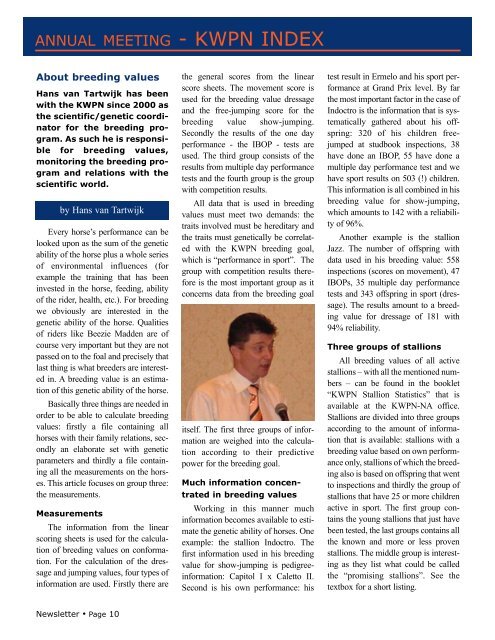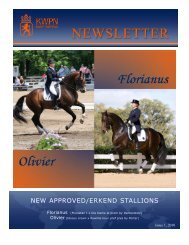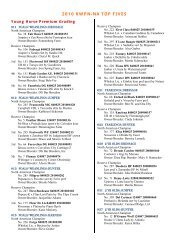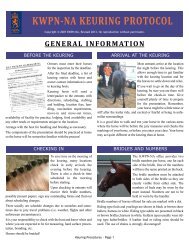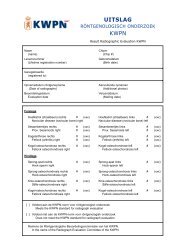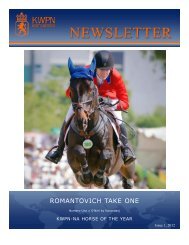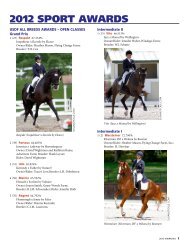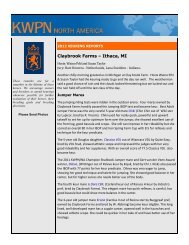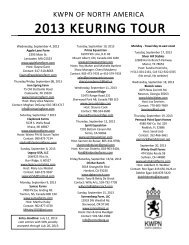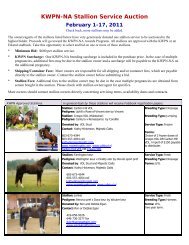Download PDF - KWPN
Download PDF - KWPN
Download PDF - KWPN
Create successful ePaper yourself
Turn your PDF publications into a flip-book with our unique Google optimized e-Paper software.
ANNUAL MEETING - <strong>KWPN</strong> INDEX<br />
About breeding values<br />
Hans van Tartwijk has been<br />
with the <strong>KWPN</strong> since 2000 as<br />
the scientific/genetic coordinator<br />
for the breeding program.<br />
As such he is responsible<br />
for breeding values,<br />
monitoring the breeding program<br />
and relations with the<br />
scientific world.<br />
by Hans van Tartwijk<br />
Every horse’s performance can be<br />
looked upon as the sum of the genetic<br />
ability of the horse plus a whole series<br />
of environmental influences (for<br />
example the training that has been<br />
invested in the horse, feeding, ability<br />
of the rider, health, etc.). For breeding<br />
we obviously are interested in the<br />
genetic ability of the horse. Qualities<br />
of riders like Beezie Madden are of<br />
course very important but they are not<br />
passed on to the foal and precisely that<br />
last thing is what breeders are interested<br />
in. A breeding value is an estimation<br />
of this genetic ability of the horse.<br />
Basically three things are needed in<br />
order to be able to calculate breeding<br />
values: firstly a file containing all<br />
horses with their family relations, secondly<br />
an elaborate set with genetic<br />
parameters and thirdly a file containing<br />
all the measurements on the horses.<br />
This article focuses on group three:<br />
the measurements.<br />
Measurements<br />
The information from the linear<br />
scoring sheets is used for the calculation<br />
of breeding values on conformation.<br />
For the calculation of the dressage<br />
and jumping values, four types of<br />
information are used. Firstly there are<br />
the general scores from the linear<br />
score sheets. The movement score is<br />
used for the breeding value dressage<br />
and the free-jumping score for the<br />
breeding value show-jumping.<br />
Secondly the results of the one day<br />
performance - the IBOP - tests are<br />
used. The third group consists of the<br />
results from multiple day performance<br />
tests and the fourth group is the group<br />
with competition results.<br />
All data that is used in breeding<br />
values must meet two demands: the<br />
traits involved must be hereditary and<br />
the traits must genetically be correlated<br />
with the <strong>KWPN</strong> breeding goal,<br />
which is “performance in sport”. The<br />
group with competition results therefore<br />
is the most important group as it<br />
concerns data from the breeding goal<br />
itself. The first three groups of information<br />
are weighed into the calculation<br />
according to their predictive<br />
power for the breeding goal.<br />
Much information concentrated<br />
in breeding values<br />
Working in this manner much<br />
information becomes available to estimate<br />
the genetic ability of horses. One<br />
example: the stallion Indoctro. The<br />
first information used in his breeding<br />
value for show-jumping is pedigreeinformation:<br />
Capitol I x Caletto II.<br />
Second is his own performance: his<br />
test result in Ermelo and his sport performance<br />
at Grand Prix level. By far<br />
the most important factor in the case of<br />
Indoctro is the information that is systematically<br />
gathered about his offspring:<br />
320 of his children freejumped<br />
at studbook inspections, 38<br />
have done an IBOP, 55 have done a<br />
multiple day performance test and we<br />
have sport results on 503 (!) children.<br />
This information is all combined in his<br />
breeding value for show-jumping,<br />
which amounts to 142 with a reliability<br />
of 96%.<br />
Another example is the stallion<br />
Jazz. The number of offspring with<br />
data used in his breeding value: 558<br />
inspections (scores on movement), 47<br />
IBOPs, 35 multiple day performance<br />
tests and 343 offspring in sport (dressage).<br />
The results amount to a breeding<br />
value for dressage of 181 with<br />
94% reliability.<br />
Three groups of stallions<br />
All breeding values of all active<br />
stallions – with all the mentioned numbers<br />
– can be found in the booklet<br />
“<strong>KWPN</strong> Stallion Statistics” that is<br />
available at the <strong>KWPN</strong>-NA office.<br />
Stallions are divided into three groups<br />
according to the amount of information<br />
that is available: stallions with a<br />
breeding value based on own performance<br />
only, stallions of which the breeding<br />
also is based on offspring that went<br />
to inspections and thirdly the group of<br />
stallions that have 25 or more children<br />
active in sport. The first group contains<br />
the young stallions that just have<br />
been tested, the last groups contains all<br />
the known and more or less proven<br />
stallions. The middle group is interesting<br />
as they list what could be called<br />
the “promising stallions”. See the<br />
textbox for a short listing.<br />
Newsletter • Page 10


